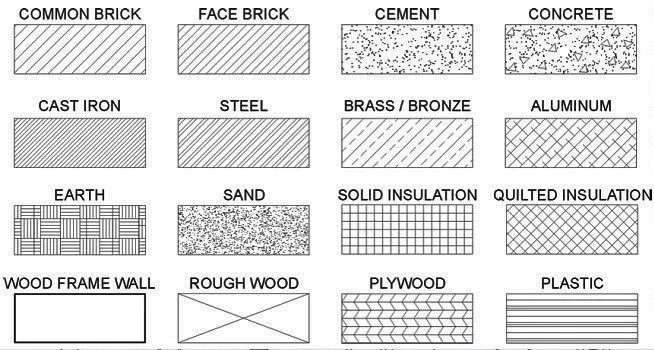In drawings representing all metals, the material symbol that is frequently used is the symbol for gold. This common practice simplifies the visual portrayal of various metals, offering a universal representation. Gold’s distinctive symbol, Au, is easily recognizable and stands in for the broader category of metals in technical illustrations and diagrams. Its prominence as a symbol for metals underscores the enduring significance of gold throughout human history. The use of the Au symbol serves as a visual shorthand, streamlining communication in the intricate world of drawings and technical design.
What Material Symbol is Frequently Used in Drawings to Represent All Metals?
The Importance of Symbols in Drawings
When we look at drawings, especially technical ones, we often see symbols that represent various elements, materials, or components. These symbols help us understand the drawing better and convey specific information quickly. One common symbol used in drawings to represent all metals is a versatile and widely recognized icon.
Understanding the Material Symbol for Metals
Have you ever noticed a simple symbol that looks like three horizontal lines stacked on top of each other? This symbol, known as the universal material symbol for metals, is used extensively in technical drawings to indicate any metal material, regardless of its specific composition.
When an engineer or a designer uses this symbol in a drawing, it tells the person reading it that the part or component specified is made of a metal material. This simplifies the communication process and ensures everyone involved in the project understands the material requirements without ambiguity.
Why a Standardized Symbol for Metals?
Standardization of symbols in technical drawings is essential for clear communication in various industries such as engineering, construction, manufacturing, and architecture. By using a universal symbol for metals, professionals can avoid confusion and errors that may arise from misinterpretation of material specifications.
Evolution of Material Symbols in Drawings
The use of symbols to represent materials in drawings dates back centuries when architects and craftsmen developed unique ways to communicate material choices without relying solely on written descriptions. Over time, these symbols evolved and became standardized to improve efficiency and accuracy in conveying technical information.
In modern engineering and design, the material symbol for metals has become a fundamental element of technical drawings, enabling professionals to convey critical information quickly and accurately. Its simplicity and universality make it an indispensable tool in various industries where precise material specifications are essential.
The Versatility of the Metal Symbol
One of the key strengths of the material symbol for metals is its versatility. Regardless of the specific type of metal being used – whether it’s steel, aluminum, copper, or any other metal – the symbol effectively communicates that the material in question is a metal.
This versatility is particularly useful in situations where the exact composition of the metal is not crucial to understanding the drawing. By using a single symbol to represent all metals, professionals can focus on conveying other essential details without getting bogged down in specific material specifications.
Applications of the Metal Symbol in Different Industries
The material symbol for metals finds widespread application in various industries where technical drawings play a crucial role in design, production, and construction processes. Let’s explore how this universal symbol is used in different contexts:
Engineering and Manufacturing
In engineering and manufacturing fields, precise material specifications are vital to ensure the safety and performance of components and structures. By incorporating the metal symbol in technical drawings, engineers can communicate the use of metal materials for specific parts or assemblies without ambiguity.
Architecture and Construction
Architects and construction professionals also rely on the metal symbol to indicate the use of metal elements in building designs. Whether it’s steel beams in a skyscraper or aluminum frames in a modern facade, the universal metal symbol simplifies material communication in architectural drawings.
Automotive and Aerospace
In industries like automotive and aerospace, where lightweight yet durable metals are commonly used, the material symbol for metals plays a crucial role in specifying components and materials in technical drawings. This symbol helps streamline the design and manufacturing processes in these high-precision sectors.
Enhancing Communication and Efficiency
By adopting standardized symbols like the material symbol for metals in technical drawings, professionals across various industries can enhance communication, minimize errors, and improve overall efficiency in design, production, and construction processes. Clear and unambiguous material specifications are essential for ensuring the quality and safety of finished products.
In conclusion, the simple yet powerful material symbol for metals serves as a universal language in technical drawings, enabling professionals to convey material information accurately and efficiently. Its widespread use across different industries highlights its importance as a fundamental tool for clear communication and seamless collaboration in the world of design and engineering.
Contract documents drawings and specifications
Frequently Asked Questions
What material symbol is commonly used to represent all metals in drawings?
In drawings, the symbol often used to represent all metals is a simple diagonal line or cross-hatching pattern. This visual representation helps indicate to the viewer that the material shown is a metal without having to specify a particular type of metal.
How does using a diagonal line or cross-hatching to symbolize metals benefit in technical drawings?
Using a diagonal line or cross-hatching for metals in technical drawings provides a universal and clear indication of metal material. It helps in easily differentiating metal components from other materials, aiding in a quick and accurate understanding of the drawing.
Why is it important to have a standard symbol for representing metals in drawings?
Having a standard symbol for representing metals in drawings ensures consistency and clarity across different technical drawings. It helps avoid confusion and misinterpretation, especially in engineering and construction fields where precise material identification is crucial.
Final Thoughts
In conclusion, the material symbol frequently used in drawings to represent all metals is a simple zigzag line. This symbol effectively conveys the presence of any metal in technical diagrams and illustrations. Its universal recognition makes it a convenient tool for visual communication. Therefore, when identifying metal components in drawings, keep an eye out for this distinctive symbol.
 home depot coupons moving helping customers save on essential home supplies
home depot coupons moving helping customers save on essential home supplies 
